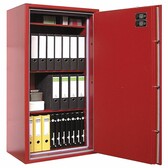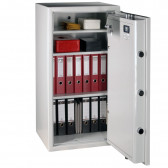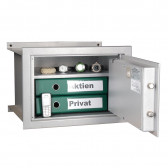If the names Kwinto or Dane don't say anything to you, and 'Vandyke' is, in your opinion, the name of a drink based on gin, Sprite and a low-salt cucumber, here is an article that will change a lot in your life. Today we take a look back at more than 100 years of the industry's history from its golden age in the inter-war years to today's security systems.
What is burglary?
Let's start at the beginning. There is a safe, and in the safe there is money, valuables, gold, securities. Burglary, in a nutshell, is about getting to the contents in the shortest possible time and escaping the scene without being caught by the police or security. Although the task is by no means easy, the contents of someone else's safe have always aroused the desire of more or less skilled burglars. The whole operation, then as now, had to be well prepared.
Recognition
Professional burglars never act alone. Existing semi-literate connections allow them to gather the information needed to carry out the burglary, such as the estimated value of the safe's contents, the presence of security guards, the building's security and other circumstances that might prove troublesome on the spot.
Preparation
Between the two world wars, a popular way for a safe or vault to fall prey to a cashier was through undermining. For example, after gaining information about the immediate neighbourhood, the legendary 'Vandyke' would buy the building adjacent to the bank and dig an 80-metre tunnel to look into the vault.
Funding
Both the collection of relevant data and the preparation for the heist, including the payment of people, equipment, possible bribes or even the purchase of property, required adequate financing. Therefore, there have been cases of a shaykh of burglars carrying out several heists on minor targets, such as a jewellery shop, to raise funds. there are known cases of setting up a business in a nearby location to have time to dig a tunnel.
The first safes
The vault as a place to store gold or money is an invention whose firsts can be found as far back as antiquity. In more recent times, safes and vaults were already made of steel and the contents were protected by a, sometimes very ingenious, lock. On YouTube, for example, you can watch a film showing how complex these mechanisms could be*.
However, such a lock is extremely impractical and when safes became a common fixture in shops, banks and even homes of wealthy people, locks were developed that could be used on a day-to-day basis. The construction of the safes consisted, as can be seen perfectly in Juliusz Machulski's "Vabank", a film set in interwar Warsaw, of a thick but uniform steel plate.
How were safes opened?
The cashiers of days gone by therefore had two ways to get their sticky paws on the loot.
The first was an acetylene torch, which was used to literally burn a hole in the cash box. The procedure was rather lengthy, and as a result of burning through the armour, the contents of the safe could be damaged. After all, for which I vouch personally, cash is flammable.
The second way, much more sophisticated, was to open the combination lock by hand, and it was around this rare skill that the legend of pre-war cashiers grew. The combination locks in use at the time could be worked out "by ear". A skilled cracksman using a stethoscope would be able to detect the moment when the mechanism jumped. Opening a lock by ear, without the use of a stethoscope, was the main asset of the film's Henryk Kwinto.
Present-day safes
Fortunately for safe keepers, the world has moved on and modern safes are much more sophisticated devices. In the course of a kind of arms race, and in response to increasingly effective methods of burglary, options for effective theft protection have emerged, making the storage of documents, valuables or cash safe.
The design of safes
Today's burglary safes have a multi-walled construction in which the body and door, depending on the resistance class chosen, consist of multiple layers of steel and special concrete. A single steel plate, even a thick one, is relatively easy to burn through. Several plates punctuated by a different substance require a change of drill bits, which extends the drilling time and avoids a break-in within dozens of minutes.
A fireproof safe
Pre-war safes boasted an unknown fire resistance. A modern fireproof safe is subjected to rigorous safety tests at the manufacturing stage and is also certified in accordance with EN 1047-1, which confirms a fire resistance of 60-120 minutes.
During the test, such a safe is subjected to prolonged exposure to high temperatures of more than 1,000 degrees. If the contents of the safe are not destroyed within the reference time, the safe is guaranteed to be fire-resistant.
Combination, electronic or biometric lock
With the development of digital technology, modern locks have emerged that can meet even the most demanding expectations. The current mechanical combination locks on offer operate on a similar principle to that of 100 years ago, but their operation is completely silent, so no safe-cracker can get away with anything, even with a stethoscope.
We offer electronic locks that meet stringent security standards and allow multiple users to be programmed for use in a multi-person office. Electronic locks are chosen most often because of the way they are used – simply enter the 6-digit code and turn the handle.
Customers who want the most innovative solutions can choose a biometric lock, which recognises fingerprints with the help of a reader.
What should you look for to choose a good safe?
When looking for a safe, you need to answer many questions. Existing solutions allow you to effectively secure things such as cash, documents, jewellery or watches. Safes for documents or other items of significant value are products that you choose for many years and you need to think about what do you want most. It's worth getting professional advice, and we encourage you to contact us directly and talk about it. By the way, it is also worth reviewing the other articles from our blog, I particularly encourage you to read the material on safes for storing weapons and valuables.
Read further: Safes in the cinema
Is it worth protecting belongings against fire in a fireproof safe?
* https://www.youtube.com/watch?v=Tmrfg3Q-kos





